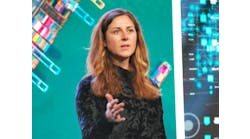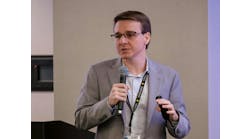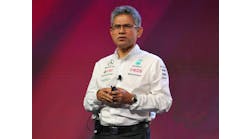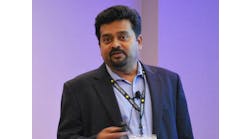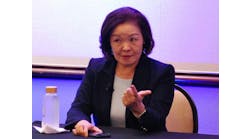Female engineers call for open communications
During their collective 96 years of work in the process industries, the four female experts on the “Women in Engineering” panel at this week’s YNOW2024 conference in Houston have experienced slights, microaggressions and other ham-handed behavior from male coworkers, who still make up the vast majority of engineering staff and management across the process industries. They unanimously agreed that conditions have improved over the years, but they also remained careful, patient and diplomatic in how they presented their experiences, analysis and advice.
“I worked for 20 years in LNG [liquified natural gas], but I started at a paper mill that was going bankrupt, and the only way to stay afloat there was to automate and innovate,” said Casey Briseno (left in photo), new energies VP at Tallgrass Energy, which operates oil and gas pipelines and infrastructure, but it also develops ammonia, hydrogen and other sustainable energy sources. “I kept on doing this during my career, and it enabled me to grow.”
A warmer world aided by OPA
“I still seek out new technologies, but now I’m doing it to fight climate change,” explained Briseno. “Many of these technologies, but especially hydrogen and ammonia production, have been available for 30 years. However, we have to make them usable by everyone for us to have a low carbon future.”
Several of the other panelists reported that their professional backgrounds and continuing journeys have led them to sustainability.
Likewise, Stephanie Brouse (second from left in photo), director of concept design and engineering at Energy Product Partners, added that not enough attention is focused on the one-third of the world’s population that has no access to clean cooking methods. “Millions of people are still burning coal and wood, which pollutes their homes,” said Brouse. “They need to bring clean cooking technology to Africa and India, which would help make the world a healthier place.”
Kelly Li (rightmost in photo), commercial lead for Open Process Automation (OPA) at ExxonMobil, added that her new role working with OPA technologies is equally transformative because it provides an open control architecture that challenges many old ways. “We also need a diverse team to apply OPA, that can also challenge the status quo, and further adapt new technologies,” said Li.
Open process emotions
Though all her mentors were men, senior supervisors—and often allies—Briseno reported that before working at Tallgrass, she worked with three young women who experienced repeated microaggressions from their male colleagues.
“There were questions like, ‘Does she really have the experience for this job?’ or ‘Has she really been in the field?’ And they were asked often enough that these three women didn’t speak up at staff meetings that were held in an open, male-dominated bullpen,” said Briseno. “They eventually opened up to me, and I talked to senior management, and at the next meeting, everyone was asked in turn to talk about their strengths and weaknesses. When I left that firm later, two of the three women thanked me, and said they likely wouldn’t have stayed there without that discussion. It was a real Mama Bear moment for me. Many times, we don’t understand how people feel from what we can see and hear.”
Likewise, Brouse reported that she was inspired to pursue a career in science, technology, engineering and math (STEM) after a sixth-grade teacher actually ripped up one of her drawings, but she won a science fair soon after. “I decided I wanted a job that wasn’t subjective, but could be proven with numbers,” said Brouse.
Support at the start
Early in her career, Yoko Fujita (second from right in photo), now head of global business services at Yokogawa, wondered if she could do the same jobs as men, and her boss supported her and affirmed that she could. “Over time, I saw that women could succeed in the same jobs,” added Fujita. “And during training, we learned how important it is to practice speaking up. This can also break down stereotypes and show that women have the potential to be leaders. And, if you discover that you have that potential, then enjoy being a leader, and take the next step.”
Because of all the challenges she and her colleagues had to overcome, Li added she was grateful to get help from mentors and advocates. More recently, she’s excited when she gets the chance to pay it forward, serve as a role model and provide the same support to others. “Years ago, I was asked by my team leader to make a presentation on gender diversity,” said Li. “The team was mostly men, but I still highlighted the lack of diversity, and my presentation was well-accepted. Since then, whenever other female colleagues are promoted to leadership roles, those senior engineers let me know.
“This is a constant reminder to me that we need to do more,” Li added. “When we promote gender diversity, we’re not just helping women. We’re also helping our whole company and industry. This is why it’s so important to help others and make them feel appreciated.”
Practice seeing details
To inspire male colleagues to open up and communicate more effectively, Briseno reported that an important start is simply to be observant. “It’s important to pay attention, know who’s talking, take note of facial expressions, and try to develop some emotional intelligence,” she said. “In that big, male bullpen, the men were all laughing and joking, but the young women were not. So, if you see someone who appears to be an outcast, speak up. Ask if they’re okay and offer to help.”
Li reported that the same process for learning about, understanding and adapting to new technologies can also be used to draw out reticent colleagues. “In both cases, it’s important to practice active listening, so all parties can understand root causes and likely differences in their expectations, and seek mitigation steps that will ease their transition to a better situation,” she explained.
Recruit, retain and practice
To alleviate the chronic and continued underrepresentation of women in technical and managerial roles, the panelists recommended several strategies.
“I advocate for hiring out of school and paying as much as you can,” said Briseno. “Even though 51% of incoming engineering graduates are women, they’re still not hired as easily as men. We have to get hiring managers and human resources more closely involved, so we can do more for young people to get them started on the right foot.”
She added that the onboarding process needs to be similarly proactive and applicable to all new employees. “It’s crucial to make people comfortable when they’re learning the ropes. As part of our onboarding, we do a 90-day peer mentorship program for all new hires. This isn’t with their boss. Instead, it’s simply a peer that can keep them engaged, help them not be too shy, and let them feel like they can speak their mind and show what they do best.”
“We strive to have everyone feel like they can come to work and be themselves. We’re all human, so we can all find a connection and a way to bond with each other. And, if one or a few of us get help to be better, then we’re all doing better.”
Because these interpersonal skills can be difficult to use, Brouse added they can be practiced by managers, coworkers, veterans, rookies and pretty much anyone else. “Role playing to practice these communication skills can be very helpful, especially for young women,” explained Brouse. “This is because it establishes a network, and lets each participant know they have someone to talk to.”



